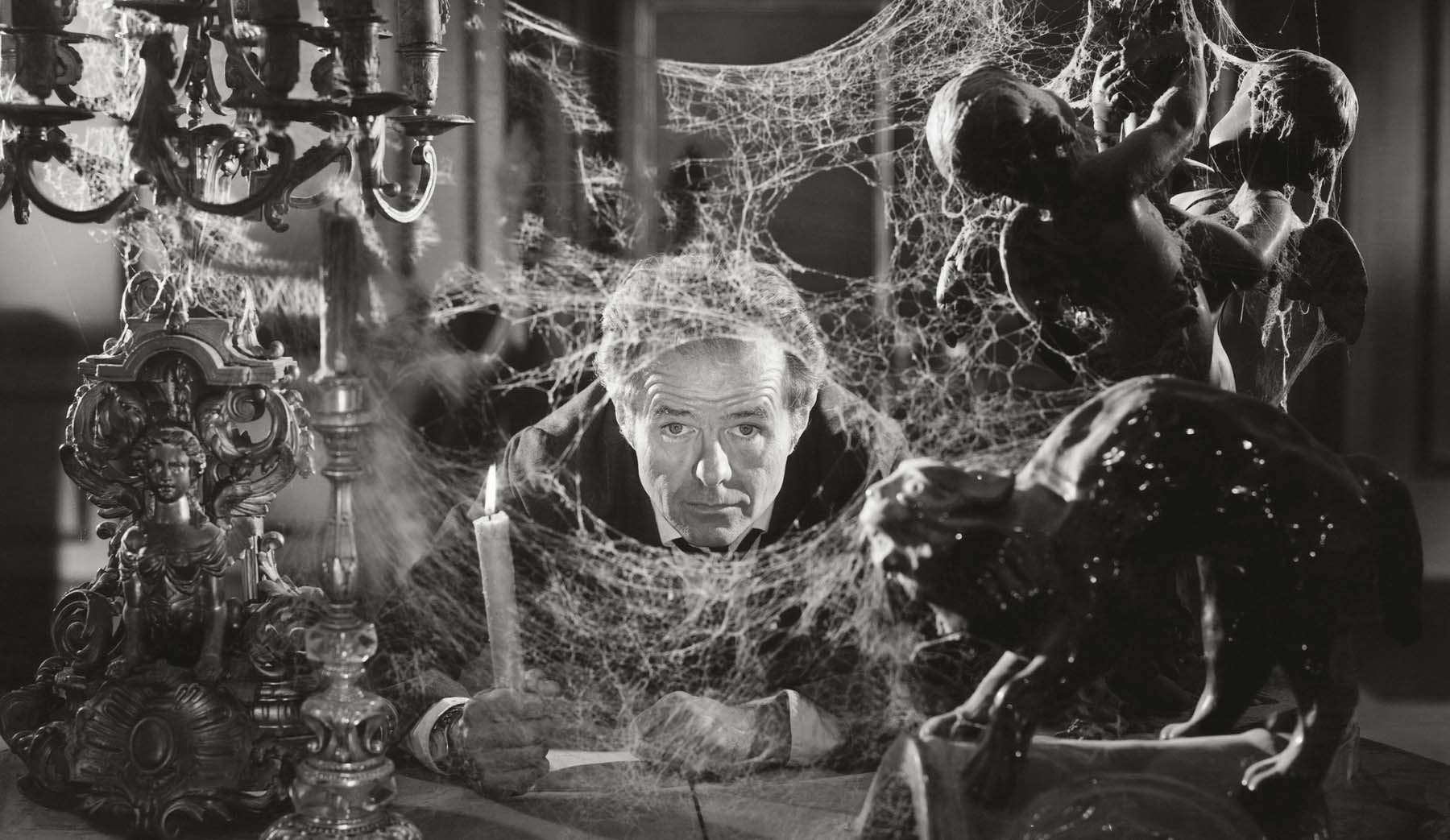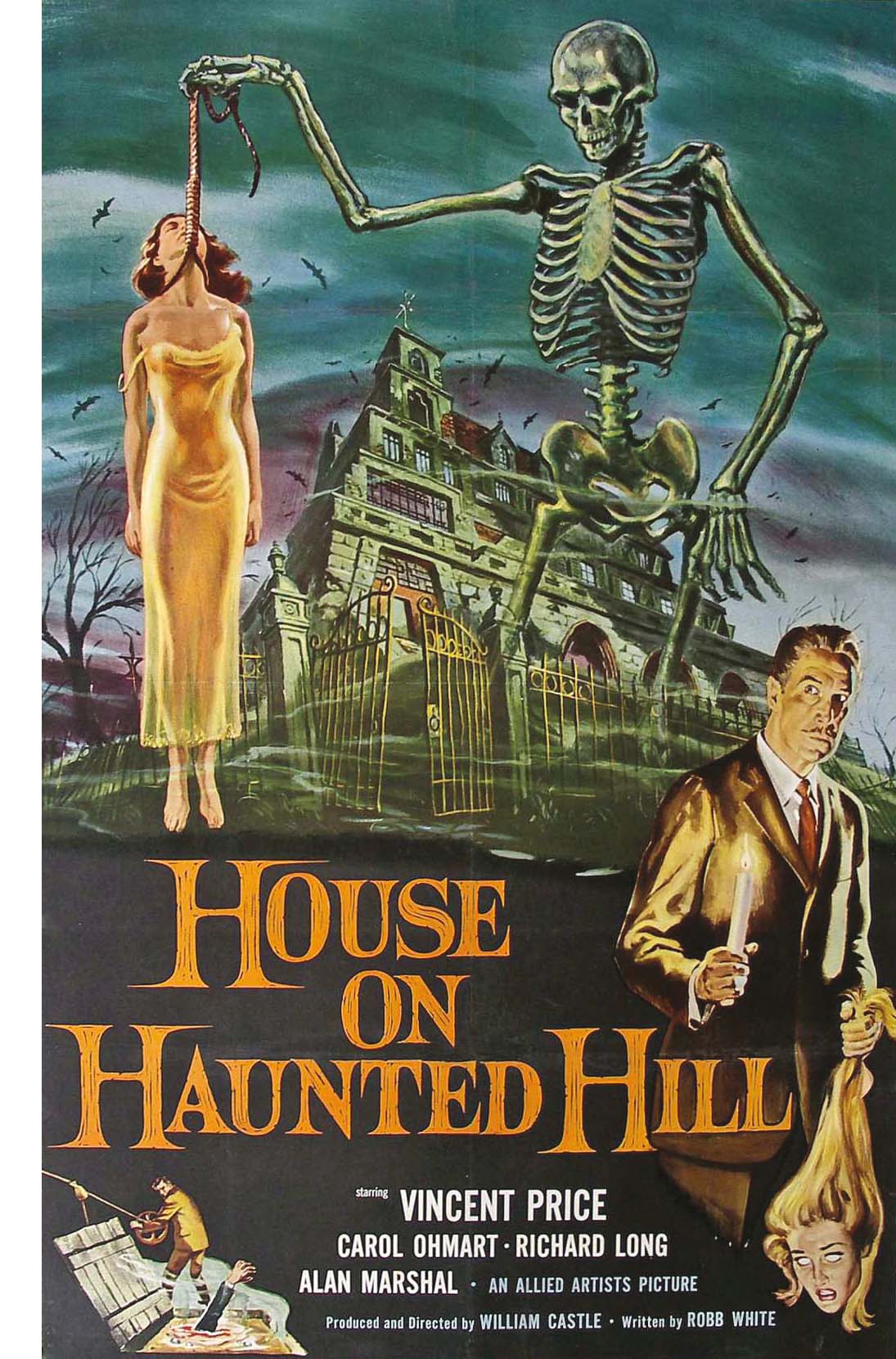WANT TO SUCCESSFULLY HAUNT A HOUSE? FIRST, YOU’VE GOT TO HAVE A GIMMICK.…
House on Haunted Hill may be one of the most preposterous movies ever made—and one of the most enjoyable. It was produced by William Castle, who, as a youngster in New York named Bill Schloss, went to see Bela Lugosi in the original Broadway production of Dracula and was deeply impressed by the gimmicky ballyhoo employed by the Fulton Theater. An ambulance was parked in front of the theater, with an ominous sign posted on it: “A NURSE WILL BE IN ATTENDANCE AT ALL PERFORMANCES.” Indeed, a “registered nurse” patrolled the aisles with smelling salts, which were usually administered to at least one audience member, who seemed to always scream on cue at the second-act curtain, when Dracula sinks his fangs into the heroine’s throat.
The burgeoning showman never forgot the stunt, and he concocted something similar for his first film, a grim little thriller called Macabre (1958): he convinced Lloyd’s of London to insure everyone in the world who saw the film against death by fright. For his next picture, in addition to another brash gimmick, he prioritized the casting of a major horror star. Following House of Wax (1953), The Mad Magician (1954), and The Fly (1958), there was no one in Hollywood who embodied the category like Vincent Price. Castle couldn’t afford Price’s salary demand for House on Haunted Hill, but he wanted the actor so badly that he offered him a percentage of the profits. Price later called it one of his shrewdest negotiations and pointed to a priceless impressionist painting in his art collection to show just how lucrative the world of low-budget horror movies could be.
House on Haunted Hill is certainly no work of art, but it is a demented masterwork of its kind: a movie so ridiculous, so full of nonsensical plot twists, and demanding so much suspension of disbelief from the viewer that it transcends its own deficiencies, rising to the sublime plane of unadulterated camp. Frederick Loren (Price) is a millionaire who, to please his detested wife, Annabelle (Carol Ohmart), invites five strangers (who he has determined are all desperate for money) to an overnight party at a house where several murders have been committed and that is believed to be haunted. The guests comprise Lance Schroeder (Richard Long), a test pilot; Ruth Bridgers (Julie Mitchum, sister of Robert), a newspaper columnist; Dr. David Trent (Alan Marshal), a psychiatric specialist in the treatment of hysteria; Nora Manning (Carolyn Craig), a low-level employee at one of Loren’s companies; and Watson Pritchard (Elisha Cook Jr.), the property’s owner, who seems equally possessed by alcohol as by the malignant spirits of the house itself.

The brooding owner, Watson Pritchard (Elisha Cook Jr.)

Original one-sheet poster
The guests are given a challenge: they will be locked in the house with no means of exit, but those who survive the night will receive a payment of $10,000 each. As party favors, they are given loaded pistols. The rest of the film consists of one creepy set piece after another. For no good reason, a chandelier crashes to the floor, narrowly missing Nora. There’s a vat of acid in the cellar, left over from one of the murders. During a pair of Lady Macbeth–like interludes, Ruth experiences blood dripping onto her hands from the ceiling. In a scene that remains startling even after repeated viewings, Nora encounters an unearthly, grimacing old woman who seems to float through the cellar. Not long after, she discovers a severed head in her overnight case. She screams, very loudly. After Annabelle is discovered hanging from a noose in a stairwell, Nora sees her apparition hovering outside her window as the end of the hanging rope snakes into the room and coils around her feet. Everyone suspects everybody, especially their host, and they all finally decide to stay in their rooms until morning. No one, of course, adheres to the resolution. It would be too logical to do so.